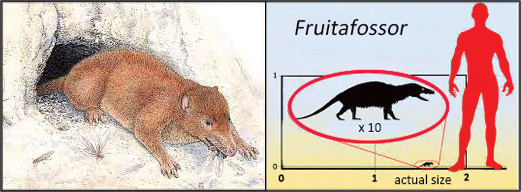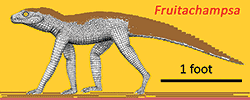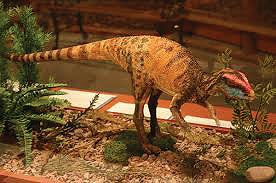PALEO HAPPENINGS July 2021 |
|||||||||
| Fruita’s Paleontological Hat Trick and a Jurassic fossil named ‘Popeye’by Martin Lockley, Moab Giants | |||||||||
In the last two Paleo Happenings we explored “classic Jurassic” reptilian fossils, including big dinosaurs and their smaller reptilian relatives from the crocodile tribe. As mammals, we humans should not overlook our own Jurassic ancestors, although we might be forgiven such oversight because the traditional view is that mammals were small and inconspicuous during the Age of Dinosaurs. Thus, paleontologists have spoken of mammals ‘in the shadow of dinosaurs’ or ‘under their feet.’ But mammals appeared at the same time as dinosaurs some 210+ million years ago, so two thirds of their history took place before the dinosaurs died out, and as we know they survived the dinosaur extinction, (unless we count birds as living dinosaurs). The famous Morrison Formation from which so many dinosaurs have been excavated has actually yielded a remarkable diversity of about 30 small mammals including one named Morrisonodon (meaning Morrison tooth). This remind us that many Jurassic mammals are known mostly from their erosion-resistant enamel teeth. This has encouraged paleontologists to nickname fossil mammal researchers as “paleo-dentists.” This total of ~30 mammal species is four or five times as many as there are species in many other groups (fish, amphibians, lizards or crocodilians) in the Morrison, and this is a measure of evolutionary success.
Another measure of success is the diversity of adaptations and anatomy. One of the Dinosaur Diamond’s iconic Jurassic mammals is Fruitafossor meaning “digger from Fruita.” It was described, in 2005, in the prestigious journal Science as a chipmunk-sized anteater-, or armadillo-like species with powerful mole-like front limbs for digging: hence bulging forearms and the nickname “Popeye” for a species that probably ate insects (not spinach)! Fruita, Colorado officially landed on the Paleontological map in 1977 when the Fruita Paleontological Area (FPA) was created almost a generation before the Dinosaur Diamond. In 1975 a geology professor from California, George Callison, brought students to the area who helped find many valuable fossils. One would later be named Fruitachampsa callisoni and dubbed the Fruita ‘crocodile-bear-cat’ or the ‘Jurassic cat.’ Some of Callison’s students are today among the best-known paleontologists of their generation, and they know both the subtle and obvious differences between crocodiles, bears and cats. In paleontology however, extinct animals often show a mixture or ‘mosaic’ of different anatomical features. Fruitachampsa is in fact a terrestrial crocodile the size of a big house cat or small bobcat. It had large cat-like canine teeth but an armored back like other small land-based Jurassic crocodiles (see Happenings, June 2021).
The large sauropod dinosaur Moabosaurus, named in 2017, celebrates Moab, but Fruita claims a hat-trick of fossils celebrating the town’s rich paleontological heritage. In addition to our champion digger ‘Popeye’ (Fruitafossor) and the cat-like croc Fruitachampsa, we round out the parade of Fruita celebrities with Fruitadens (meaning ‘Fruita tooth’), which has been dubbed as the smallest of the ornithischian dinosaurs (see reconstruction on display at the Dinosaur Journey museum in Fruita). This knee high, three-foot-long dinosaur was an ancestor of the giant duck-billed billed vegetarians that would, 75 million years later, leave footprints three feet long, enough to cover their erstwhile ancestors. Had you time travelled back to the Late Jurassic you would have been ten times the size of any mammal and you would have had a hard time telling the difference between turkey-sized Fruitadens and Fruitachampsa 100 feet away in the brush. And Fruitafossor was probably no eye-popping spectacle: more likely a glimpse of “Popeye” would have been of the rear end of a fluffy fur ball burying its’ head in the sand. But it was from such inconspicuous beginnings that the mammals went on to take over from the dinosaurs and give us our cultural heroes like “Popeye.” |
|||||||||


